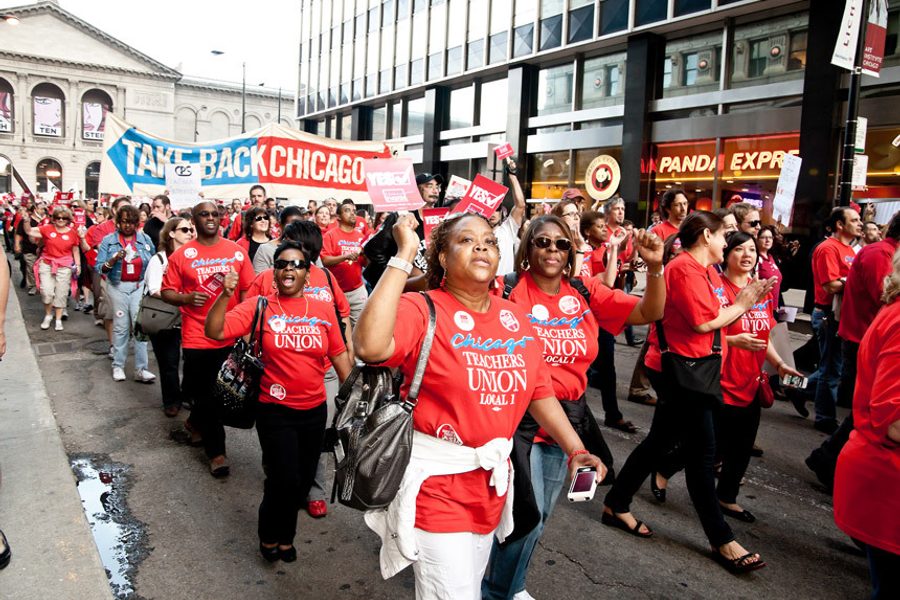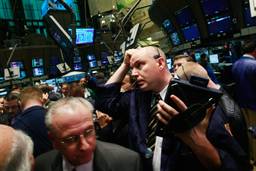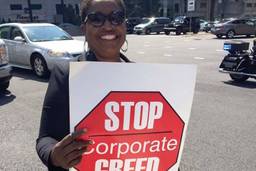
During Andrew Cuomo’s tenure as attorney general of New York, he noted, “In New York, the biggest pool of money is the state pension fund.” This is true with public pension funds across the nation — and Wall Street firms have leaped to take advantage of the bounty, often in unsavory ways. Over the last five years, the Securities and Exchange Commission (SEC) has routinely unearthed “pay-to-play” scandals, in which overseers of pension funds make investment choices based on personal gain.
In most cases, politicians control the investment-making decisions at pension funds. A select few, however, are controlled by their members — meaning they could invest in projects for the public good on Main Street rather than private investment funds on Wall Street. One such fund is the Chicago Teachers’ Pension Fund (CTPF), a nearly $10 billion pool charged with assuring the retirement security of tens of thousands of education professionals. Despite a Board composed of 12 member-elected trustees, however, Wall Street still has its hands in the kitty. Here are six ways America’s biggest investment firms have the potential to sink Chicago teachers — and just how the CTPF board can stop that from happening.
1. Underperformance
Historically, pension funds have been extremely conservative investors out of caution for their members’ finances. Only in the past 20 years have they amped up their allocations to higher-risk endeavors. And as Wall Street has quaked, so too have member livelihoods.
Over the past five years, the CTPF’s assets in traditional investments — domestic equities (stock in large, financially sound companies) and fixed income (stable bonds) — have been far more profitable than the portfolio as a whole. In that time period, the former returned 7 percent annually; in other words, if the fund had invested $100 in 2008, it would have made roughly $140 by 2014. Fixed income bonds, meanwhile, returned 6 percent. A traditional 60 percent stock, 40 percent bond portfolio, then, would have returned 6.6 percent. In order to be considered fully funded, the CTPF’s investments must return 8 percent; though neither stocks nor bonds fulfilled this completely, they were still far closer than the CTPF’s total investment return, which was a paltry 4.6 percent — a loss of around $200 million per year.
The CTPF’s performance in low-transparency, high-risk private equity and real estate was particularly poor: It returned 3.3 percent and -1.9 percent, respectively, in the last half decade.
Considering the stakes, experts say, pension fund board members should stick with safer traditional investments in bonds and stocks.
“Pension funds that load up on high-cost, high-risk investments have no excuse when they underperform traditional markets,” says Edward Siedle, a leading pensions authority and former attorney with the SEC, in an interview with In These Times.
And for teachers, such decisions have a deleterious impact beyond the health of their pensions. Legally, employers in Illinois must make up the difference if pension funds fail to garner the returns they need in the stock market. Mayor Emanuel used the 2013 required pension contribution by Chicago Public Schools of $338 million and the 2014 contribution of $612 million to justify thousands of layoffs. But if the CTPF as a whole had performed as well as its lowest-risk investments, CPS would not have had to make any contribution at all to maintain the current pension funding level — and Emanuel’s justification for the layoffs would have been lost.
2. Secrecy
As David Sirota at Pando and Yves Smith at Naked Capitalism have written, a pall of secrecy surrounds pension funds’ investments in high-risk hedge funds, private equity and real estate, also known as “alternative investments.” And the CTPF, with 12 percent of its money (as of 2013) buried in these ventures, is no exception.
Once CTPF decision-makers opt to buy into alternative investments, those investment managers take the reins in terms of reporting the health of those finances. From 2007 to 2012, the CTPF’s auditor, KPMG, admitted in its report that these investments are “hard to value.” The CTPF’s new auditor has not expressed similar trepidation about the alternative — instead, it has raised no questions at all. The CTPF has not responded to questions from In These Times as to the methodological differences between the two auditors.
This is dangerous because there is thus no way to independently verify the performance of the entire CTPF portfolio, if more than a tenth of it is calculated using the reports of the investment managers themselves, who have a clear incentive to overstate performance data in order to keep current investors and attract new ones. In other words, the already poor private equity and real estate data (which, again, severely hampered the CTPF portfolio) could be much worse.
Though In These Times has repeatedly filed Freedom of Information Act requests for contracts and performance reports with these firms, they are covered under exemptions in Illinois’ FOIA. There is one such exception that particularly matters. Passed in 2005 with almost zero news coverage, Public Act 94-0508 exempts from FOIA information about “private portfolio companies” — that is, private equity, hedge funds, and real estate firms. The law, which was heavily promoted by the Illinois Venture Capital Association, a trade group for alternative investment managers, has since been used to aggressively limit the release of information around alternative investments that would be freely available for traditional investments. Prior to 2005, pension funds would have been required to disclose the information requested.
“The secrecy surrounding public pension investments in alternatives is … the single greatest threat to the US economy in generations,” says Siedle, pointing out that more than $600 billion in public pensions have been poured into such markets.
Though the CTPF board does not have the power to change the law, he says, “The CTPF should be far more forthcoming in light of the nearly $2 billion they have invested in these opaque and untested investment strategies.” There is absolutely no FOIA mandate, after all, to hide information about alternative investments from the public. (The Board of Trustees, in fact, could even override previous FOIA determinations made by CTPF staff.)
3. Criminality
In April, the Chicago-based Northern Trust Bank received subpoenas from the SEC relating to its securities-lending practices, services it had also provided to the CTPF. In addition, NTB had also been the fund custodian, meaning that it held all assets on behalf of the fund, including stocks, bonds or shares in alternative investment firms. Two months prior to the SEC’s intercession, CTPF officials had opted to replace NTB as custodian with Bank of New York Mellon; Deutsche Bank would take over securities lending.
But these companies aren’t exactly innocent, either. In 2011, BNY Mellon was sued by the Justice Department and the New York State Attorney General’s office for scamming pension funds by overcharging them for foreign exchange transaction fees. The New York Attorney General’s office accused BNY Mellon of improperly making $2 billion from 2001 to 2011. Although the lawsuit is ongoing, minutes of the decision to name BNY Mellon the fund’s new custodian show no mention of the allegations.
Deutsche Bank, for its part, is currently embroiled in a scandal in Japan with regard to its overzealous wining-and-dining of Japanese pension fund executives.
In addition to the suspect behavior of the banks charged with stewarding CTPF assets, seven of the CTPF’s 21 alternative investment management firms have been on the receiving end of enforcement action by the SEC or the Justice Department.
4. Consultant conflicts
“Investment consultants stand as gatekeepers between large investors, such as private and public retirement funds, and those from ‘Wall Street’ who design and sell financial products,” writes Jay Youngdahl, a senior fellow at the Initiative for Responsible Investment at Harvard, in a working paper published by Harvard’s Edmond J. Safra Center for Ethics. Yet, he continues, “the profession failed to protect asset owners in the recent financial crisis.”
What’s to blame, he asks? “Institutional corruption, which takes the form of conflicts of interest, dependencies, and pay-to-play activity.”
The CTPF’s primary investment consultant, Callan Associates Inc., has been implicated in numerous unethical activities.
In 2002, the Hawaii State Auditor found that Callan had recommended that pension funds invest in money management firms with which the consultant had financial relationships; in 2007, the SEC found the same thing. A 2007 report from the Governmental Accountability Office indicated that these kinds of conflicts could cost pension funds billions of dollars. Yet the CTPF administrators still opted to contract with Callan in 2011.
“Given that the top Democrat on the House committee overseeing pensions, George Miller, has now raised the alarm again regarding pension consultant conflicts, the need for an independent investigation of the CTPF’s investment consultant is now even more compelling.” In this case, the board would charge a forensic pension investigator with finding out how much conflicts of interest have cost the CTPF.
5. Lack of a gift ban for trustees
Trustees and employees of the Chicago Teachers Pension Fund are allowed to accept gifts of up to $100 per contributing person per year — and unlimited food donations of up to $75 per contributing person per day. Given the tens of thousands of teachers in the Chicago Public School system, this can mean hundreds of free dinners a year for trustees. There is no requirement to disclose these gifts — a near-universal component of ethics laws — and there is no aggregate limit on the gifts trustees can receive.
Investment managers frequently wine-and-dine pension fund trustees and investment staff when attempting to maintain business with a fund. Craig Holman, an ethics expert with Public Citizen, feels a total gift ban is necessary to ensure that all decisions are being made with the welfare of pension fund members in mind.
“Gift-giving provides not just camaraderie, but very often instills a sense of obligation that can influence official decisions,” Holman said to In These Times in an e-mail. “There should be no sit-down dinners one-on-one with lobbyists; and no wining and dining.”
Siedle agrees that, in general, the ready availability of gifts can lead to decisions that benefit board members instead of those who depend on pension funds.
“Wining and dining can have a corrosive impact on public pension board members,” he says. Overall, “This underscores the need for a total gift ban.”
6. Political implications
While the Chicago Teachers Union fights education privatization, the CTPF is, at least indirectly, helping to finance it. The CTPF has more than $330 million invested in JP Morgan, which has created a $325 million fund to finance charter school growth nationwide; the megabank has also donated $2.5 million to support the “turnaround model” in public schools. The CTPF additionally holds $43 million in Microsoft stock, despite Bill Gates’ avowed hostility to teacher unionism. (The CTPF did not respond to multiple requests for comment on this story.)
For that matter, many of the CTPF’s other investments aren’t pristine, either. The CTPF holds $260 million of stock in British American Tobacco, the world’s second-largest tobacco company. And it holds $80 million in investments in Walton Street Capital, currently the target of a corporate campaign by UNITE HERE over violations of labor rights. The CTPF additionally holds tens of millions of dollars in investments in ExxonMobil and Chevron.
But it doesn’t have to be this way. The CTPF has a unique opportunity to wrest control of the economy from Wall Street to Main Street. At their height, pension funds were used to finance massive affordable housing co-ops in New York and around the country. These days, those in charge of the CTPF could arrange to purchase special Chicago Transit Authority bonds to build bus rapid transit — a public good that has a massive return on investment. Or it could go towards weatherizing city-owned buildings, which has similarly excellent potential.
As of now, however, the CTPF board is leaving its members vulnerable to the maneuverings of Wall Street — and pouring a significant amount of money into it, too. This doesn’t just put teachers’ pensions or jobs at risk; it also encourages a system of inequality that hurts all middle-class Americans.







